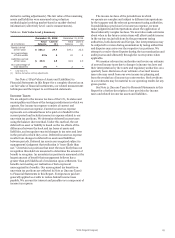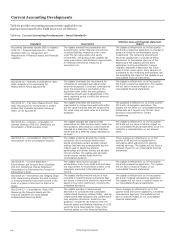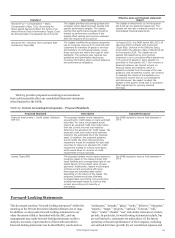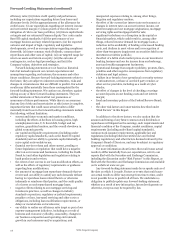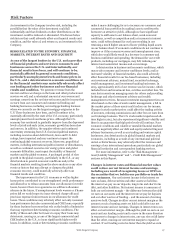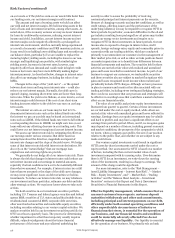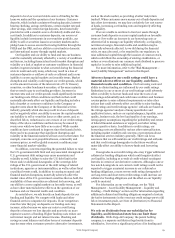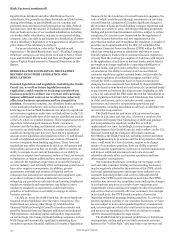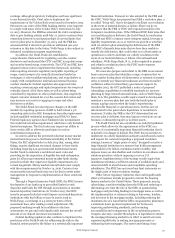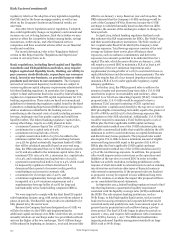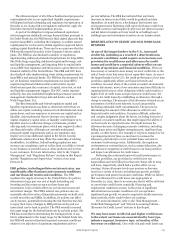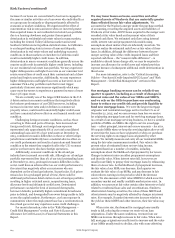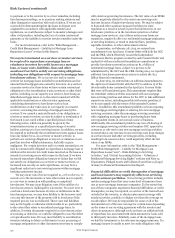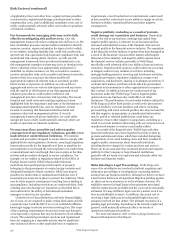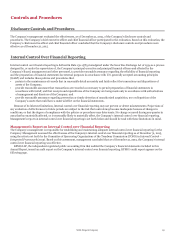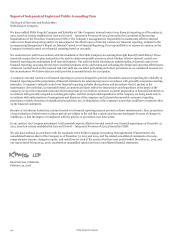Wells Fargo 2015 Annual Report Download - page 125
Download and view the complete annual report
Please find page 125 of the 2015 Wells Fargo annual report below. You can navigate through the pages in the report by either clicking on the pages listed below, or by using the keyword search tool below to find specific information within the annual report.The ultimate impact of all of these finalized and proposed or
contemplated rules on our capital and liquidity requirements
will depend on final rulemaking and regulatory interpretation of
the rules as we, along with our regulatory authorities, apply the
final rules during the implementation process.
As part of its obligation to impose enhanced capital and
risk-management standards on large financial firms pursuant to
the Dodd-Frank Act, the FRB issued a final capital plan rule that
requires large BHCs, including the Company, to submit annual
capital plans for review and to obtain regulatory approval before
making capital distributions. There can be no assurance that the
FRB would respond favorably to the Company’s future capital
plans. The FRB has also finalized a number of regulations
implementing enhanced prudential requirements for large BHCs
like Wells Fargo regarding risk-based capital and leverage, risk
and liquidity management, and imposing debt-to-equity limits
on any BHC that regulators determine poses a grave threat to the
financial stability of the United States. The FRB and OCC have
also finalized rules implementing stress testing requirements for
large BHCs and national banks. The FRB has also proposed, but
not yet finalized, remediation requirements for large BHCs
experiencing financial distress that would restrict capital
distributions upon the occurrence of capital, stress test, or risk
and liquidity management triggers. The OCC, under separate
authority, has also established heightened governance and risk
management standards for large national banks, such as
Wells Fargo Bank, N.A.
The Basel standards and federal regulatory capital and
liquidity requirements may limit or otherwise restrict how we
utilize our capital, including common stock dividends and stock
repurchases, and may require us to increase our capital and/or
liquidity. Any requirement that we increase our regulatory
capital, regulatory capital ratios or liquidity could require us to
liquidate assets or otherwise change our business, product
offerings and/or investment plans, which may negatively affect
our financial results. Although not currently anticipated,
proposed capital requirements and/or our regulators may
require us to raise additional capital in the future. Issuing
additional common stock may dilute the ownership of existing
stockholders. In addition, federal banking regulations may
increase our compliance costs as well as limit our ability to invest
in our business or provide loans or other products and services
to our customers. For more information, refer to the “Capital
Management” and “Regulatory Reform” sections in this Report
and the “Regulation and Supervision” section of our 2015
Form 10-K.
FRB policies, including policies on interest rates, can
significantly affect business and economic conditions
and our financial results and condition. The FRB
regulates the supply of money in the United States. Its policies
determine in large part our cost of funds for lending and
investing and the return we earn on those loans and
investments, both of which affect our net interest income and
net interest margin. The FRB’s interest rate policies also can
materially affect the value of financial instruments we hold, such
as debt securities and MSRs. In addition, its policies can affect
our borrowers, potentially increasing the risk that they may fail
to repay their loans. Changes in FRB policies are beyond our
control and can be hard to predict. The FRB recently increased
the target range for the federal funds rate by 25 basis points. The
FRB has stated that in determining the timing and size of any
future adjustments to the target range for the federal funds rate,
the FRB will assess realized and expected economic conditions
relative to its objectives of maximum employment and two
percent inflation. The FRB has indicated that any future
increases in interest rates likely would be gradual and data
dependent. As noted above, a declining or low interest rate
environment and a flattening yield curve which may result from
the FRB’s actions could negatively affect our net interest income
and net interest margin as it may result in us holding lower
yielding loans and investment securities on our balance sheet.
RISKS RELATED TO CREDIT AND OUR MORTGAGE
BUSINESS
As one of the largest lenders in the U.S., increased
credit risk, including as a result of a deterioration in
economic conditions, could require us to increase our
provision for credit losses and allowance for credit
losses and could have a material adverse effect on our
results of operations and financial condition. When we
loan money or commit to loan money we incur credit risk, or the
risk of losses if our borrowers do not repay their loans. As one of
the largest lenders in the U.S., the credit performance of our loan
portfolios significantly affects our financial results and
condition. As noted above, if the current economic environment
were to deteriorate, more of our customers may have difficulty in
repaying their loans or other obligations which could result in a
higher level of credit losses and provision for credit losses. We
reserve for credit losses by establishing an allowance through a
charge to earnings. The amount of this allowance is based on our
assessment of credit losses inherent in our loan portfolio
(including unfunded credit commitments). The process for
determining the amount of the allowance is critical to our
financial results and condition. It requires difficult, subjective
and complex judgments about the future, including forecasts of
economic or market conditions that might impair the ability of
our borrowers to repay their loans. We might increase the
allowance because of changing economic conditions, including
falling home prices and higher unemployment, significant loan
growth, or other factors. For example, if oil prices remain low for
a prolonged period of time, we may have to increase the
allowance, particularly to cover potential losses on loans to
customers in the energy sector. Additionally, the regulatory
environment or external factors, such as natural disasters, also
can influence recognition of credit losses in our loan portfolios
and impact our allowance for credit losses.
Reflecting the continued improved credit performance in
our loan portfolios, our provision for credit losses was
$450 million and $1.6 billion less than net charge-offs in 2015
and 2014, respectively, which had a positive effect on our
earnings. Future allowance levels may increase or decrease
based on a variety of factors, including loan growth, portfolio
performance and general economic conditions. While we believe
that our allowance for credit losses was appropriate at
December 31, 2015, there is no assurance that it will be sufficient
to cover future credit losses, especially if housing and
employment conditions worsen. In the event of significant
deterioration in economic conditions or if we experience
significant loan growth, we may be required to build reserves in
future periods, which would reduce our earnings.
For more information, refer to the “Risk Management –
Credit Risk Management” and “Critical Accounting Policies –
Allowance for Credit Losses” sections in this Report.
We may have more credit risk and higher credit losses
to the extent our loans are concentrated by loan type,
industry segment, borrower type, or location of the
borrower or collateral. Our credit risk and credit losses can
Wells Fargo & Company
123


